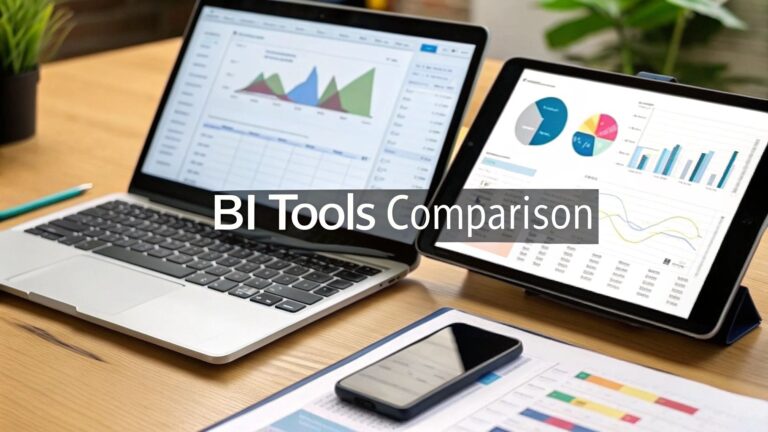Choosing Sales Qualification Frameworks That Convert
Think of sales qualification frameworks as the diagnostic tools for your sales team. They provide a structured, repeatable way to figure out which prospects are a great fit and, just as importantly, which ones are a waste of time. These systems give your reps a clear process for filtering leads so they can pour their energy into the deals that are actually likely to close.
Why Your Sales Team Needs a Qualification Framework

It’s like a doctor prescribing treatment without ever diagnosing the patient’s symptoms—it would be a shot in the dark, and potentially harmful. When a sales team chases every single lead with the same intensity, they burn through precious time and resources on opportunities that were never going to pan out. This is where a solid sales qualification framework becomes a game-changer.
At its core, a framework is just a consistent, shared set of criteria to evaluate a lead’s potential. It turns qualification from a gut-feel guessing game into a methodical, data-driven process.
By creating a unified definition of what a "qualified lead" really is, everyone on the team is on the same page, from marketing to sales development to account executives. This kind of alignment is absolutely essential for effective sales pipeline management and building a predictable growth engine.
The Real-World Impact of Structured Qualification
Bringing in a formal framework isn't just about tidying up your process; it’s about getting real business results. A structured approach pushes reps to ask the tough, important questions early on, uncovering potential deal-breakers before they sink dozens of hours into demos and proposals. That early filtering sends positive ripples across the entire sales organization.
A well-implemented qualification framework acts as a powerful filter, ensuring that only the most promising opportunities consume your team’s most valuable resource: time. This laser focus is the key to accelerating revenue and improving forecast accuracy.
The benefits really jump out when you look at the numbers. Teams using these frameworks can slash sales cycle times by up to 20-30% and see close rates climb by over 15%. This efficiency boost comes from weeding out unqualified leads early, which can improve how leads are handled by at least 25%.
Ultimately, these frameworks give your team the power to:
- Improve Forecast Accuracy: When the deals in your pipeline are properly qualified, your revenue predictions become a whole lot more reliable.
- Shorten the Sales Cycle: Reps can stop spinning their wheels on dead-end leads and focus on pushing viable prospects forward.
- Increase Win Rates: Concentrating effort on high-fit opportunities naturally results in a higher percentage of closed-won deals.
- Boost Team Morale: Nothing gets a sales rep more fired up than working on deals that have a real shot at closing.
Why BANT Isn't Always Enough for Modern Sales Teams
Sales qualification feels like a modern obsession, but it’s been around for a long, long time. In fact, its roots go back decades to when selling was a much simpler game. To really get a handle on the sophisticated frameworks we use today, it helps to see where they came from.
Our story starts with BANT, probably the most famous framework of them all. Developed by IBM way back in the 1950s, BANT—which stands for Budget, Authority, Need, and Timeline—was built to solve a very straightforward problem.
IBM had a ton of leads and needed a quick-and-dirty way to figure out which ones were actually worth a salesperson's time. BANT was the perfect tool for that job. It was essentially a simple checklist.
- Does the prospect have a budget?
- Do they have the authority to sign on the dotted line?
- Is there a clear business need?
- Is there a realistic timeline for a purchase?
If a rep could tick all four boxes, the lead was golden. For years, especially in high-volume, transactional sales, this worked beautifully.
The Game Changed, and Buying Got Complicated
But then, the business world got a lot more complex. B2B sales cycles stretched out, products became more technical, and the lone decision-maker became a rare sight. Suddenly, reps weren't selling to one person; they were navigating a maze of stakeholders on a buying committee.
This is where BANT started to fall apart. It was too rigid, treating qualification like a static checklist instead of a dynamic conversation. A rep clinging to BANT might disqualify a fantastic opportunity just because a formal budget hadn't been allocated yet, completely missing the bigger picture.
The real problem with BANT is its inflexibility. In a world of complex solutions and collaborative buying, a framework needs to guide a real discovery conversation, not just check boxes.
This need for something more substantial is what sparked the creation of advanced sales qualification frameworks like MEDDIC in the 1990s. The market was evolving, and sales methodologies had to catch up. By 2020, this shift was undeniable, with around 70% of enterprise tech sales teams using BANT, MEDDIC, or a custom hybrid to qualify their deals.
As you can see from how much B2B sales strategies have evolved, a simple checklist just doesn't cut it for the most important deals anymore.
Comparing the Most Effective Frameworks
Now that we've covered the basics, let's roll up our sleeves and look at the most popular sales qualification frameworks being used today. Each one gives you a different lens for sizing up a potential deal, shining a spotlight on specific pieces of information.
Think of them like different types of blueprints. They all help you build a house, but some are designed for a sprawling mansion, while others are perfect for a cozy bungalow. The evolution of these frameworks really tells the story of B2B sales itself—moving from simple checklists to much more sophisticated diagnostic tools.
This infographic shows that journey perfectly, from the straightforward BANT to the deep-dive analysis of MEDDIC.

What you’re seeing here is a fundamental shift in sales philosophy. We’ve moved away from a seller-focused checklist and toward a buyer-centric diagnostic process, which is exactly what you need for today’s complex sales.
To make this even clearer, let's break down the big three—BANT, MEDDIC, and CHAMP—and see how they stack up in the real world.
Sales Qualification Frameworks at a Glance
| Framework | What It Stands For | Best For | Example Question |
|---|---|---|---|
| BANT | Budget, Authority, Need, Timeline | High-velocity sales with transactional deals and a clear buying process. | "Is there a budget allocated for this project in the current quarter?" |
| MEDDIC | Metrics, Economic Buyer, Decision Criteria, etc. | Complex, high-value enterprise sales with long cycles and multiple stakeholders. | "What specific metrics will you use to measure the success of this initiative?" |
| CHAMP | Challenges, Authority, Money, Prioritization | Consultative, solution-oriented selling where the problem isn't fully defined. | "What are the biggest challenges your team is facing right now?" |
This table is a great starting point, but the real magic is in understanding the nuance behind each letter.
BANT: The Classic Qualifier
BANT is the original playbook, the one most of us learned first. It stands for Budget, Authority, Need, and Timeline. It’s a workhorse for teams in fast-paced sales environments where you need to qualify or disqualify leads quickly. Its power is its simplicity.
- Budget: Does the prospect actually have money set aside for this?
- Authority: Are you talking to the person who can sign on the dotted line?
- Need: Is there a real business pain you can solve?
- Timeline: Do they need to make a decision soon?
A quick BANT check stops reps from filling their pipeline with tire-kickers. The downside? Its rigidity can be a killer in modern, complex sales where budgets are often created for the right solution and decisions are made by a whole committee, not just one person.
MEDDIC: The Enterprise Powerhouse
When you’re chasing those massive, complex deals—think six-figure software contracts that take months or even years to close—you need something with more muscle. That’s where MEDDIC comes in. It forces a much deeper, more rigorous qualification process that can feel like you’re a detective on a case.
- Metrics: What are the hard numbers the buyer needs to hit? We’re talking a 15% cut in operating costs or a 20% boost in team productivity.
- Economic Buyer: Who truly holds the purse strings? This is the person with ultimate P&L responsibility who can kill the deal with a single "no."
- Decision Criteria: What’s on their technical and business checklist for choosing a vendor?
- Decision Process: How does this company actually buy things? What are the formal hoops you need to jump through from evaluation to procurement?
- Identify Pain: What happens if they do nothing? You need to uncover the painful business consequences of their current problem.
- Champion: Who is your inside person? You need someone with influence who will fight for you when you’re not in the room.
MEDDIC is brilliant at uncovering the political, financial, and technical landmines that can blow up a big deal at the last minute.
CHAMP: The Challenger's Choice
CHAMP is a more modern approach that flips the old model on its head by leading with the customer's problems. It stands for Challenges, Authority, Money, and Prioritization. This is the perfect framework for consultative selling, especially when a prospect knows they have a problem but hasn’t fully defined the solution yet.
By starting with Challenges, CHAMP encourages a more empathetic discovery process. It positions the sales rep as a problem-solver first and a vendor second, which is a powerful way to build trust with a potential buyer.
The biggest difference here is how it views authority. Instead of seeing a low-level contact as a gatekeeper (the old BANT way), CHAMP sees them as a valuable source of information—an entry point to map the organization and build a business case from the inside out. This approach pairs beautifully with a smart lead scoring system that prioritizes engagement and identified pain points. If you want to get that part of your process dialed in, exploring some lead scoring best practices is a great next step.
Other Notable Frameworks to Consider
While BANT, MEDDIC, and CHAMP dominate the conversation, a few others are worth knowing because they excel in specific situations.
- ANUM (Authority, Need, Urgency, Money): This is basically BANT but with a laser focus on getting to the decision-maker first. It's built for speed and works well in shorter sales cycles where access to power is your biggest bottleneck.
- FAINT (Funds, Authority, Interest, Need, Timeline): FAINT was designed for the modern buyer who often doesn't have a formal budget. It operates on the idea that strong interest in a killer solution can create the budget. "Funds" just confirms the company is financially healthy enough to make a purchase, even if the cash isn't earmarked yet.
Ultimately, choosing a framework isn't about finding the single "best" one. It's about finding the one that’s the best fit for your sales process, the complexity of your deals, and the kind of buyers you talk to every day.
How to Choose the Right Framework for Your Team
So, with all these sales qualification frameworks out there, how do you pick just one? The secret isn't finding the universally "best" option—it’s about finding the one that fits your business like a glove.
Think of it this way: the right framework acts like a perfectly calibrated lens, bringing your ideal customer into sharp focus. The wrong one feels like trying to solve a puzzle with pieces from a completely different box. It’s clunky and just doesn’t work.
The decision really comes down to a few core things about your business. By taking an honest look at your unique sales environment, you can confidently pick a framework that actually helps your reps, rather than bogging them down with irrelevant questions.
Analyze Your Sales Cycle and Deal Complexity
First things first, look at the kind of deals you're actually closing. A high-velocity startup selling a simple SaaS subscription has a completely different reality than an enterprise software company navigating nine-month sales cycles with multiple technical deep-dives.
Here’s what to consider:
-
Deal Size and Complexity: Is your average contract value transactional (under $10k) or is it a major strategic investment (over $100k)? Simple, lower-value deals are a great match for the speed of BANT, which is designed to quickly weed out anyone who isn't a serious buyer. On the flip side, complex, high-stakes sales absolutely demand the thoroughness of MEDDIC to uncover political landmines and prove the financial impact.
-
Sales Cycle Length: How long does it usually take to get a deal from "hello" to "closed-won"? For cycles measured in days or weeks, a simple framework keeps the momentum going. But for deals that stretch across quarters—or even years—a more in-depth framework is essential for staying in control and knowing where you stand.
-
Number of Stakeholders: Are you typically selling to a single decision-maker, or are you navigating a buying committee of ten different people? BANT is great for those one-on-one sales conversations. MEDDIC, however, was literally built to map out the complicated web of influencers, champions, and economic buyers you find in huge organizations.
The complexity of your sales process should directly mirror the complexity of your chosen framework. Forcing a complex methodology like MEDDIC onto a simple, transactional sale is a recipe for frustration and stalled deals.
Align the Framework with Your Selling Motion
Next, think about how your team actually sells. Is your style more consultative and focused on diagnosing problems, or is it a more direct, feature-and-benefit pitch? This is a huge piece of the puzzle, because the framework needs to feel natural inside your reps' conversations.
If you have a consultative selling motion where reps act more like trusted advisors, CHAMP will feel like a perfect fit. It literally starts with "Challenges," which lines up perfectly with a problem-solving approach. But if your product solves a very specific and well-understood need, a more direct framework will probably be more efficient.
At the end of the day, picking between sales qualification frameworks is really an exercise in self-awareness. Map out your sales process, get a real handle on your buyer's journey, and then choose the tool that gives your team the clarity and confidence to go after the deals they can actually win.
Putting Your Chosen Framework into Action

Picking the right sales qualification framework is a great start, but it's only half the job. The real magic happens when you make it a core part of your team's day-to-day grind. If you don't have a solid plan for rolling it out, even the best framework will just collect dust.
Getting your team on board isn't about making them memorize another acronym; it's about fundamentally changing habits. This change has to start from the top. Getting true buy-in from your sales leaders is non-negotiable—they're the ones who will drive its use and keep reps accountable.
With leadership committed, you can shift your focus to the practical side of things. The aim is to make the framework feel like a natural extension of a sales conversation, not some rigid checklist to tick off.
Creating a Practical Rollout Plan
A good rollout plan is a mix of solid training, the right tools, and consistent follow-up. The trick is to make the framework so easy and intuitive that it becomes second nature for your team.
The first step is to turn the framework's theory into a practical sales playbook. This playbook will be your team's North Star. It should include:
- Specific Discovery Questions: Under each part of your framework (like the 'Metrics' in MEDDIC), list out a few smart, open-ended questions reps can ask.
- Clear Exit Criteria: Spell out exactly what a rep needs to know before they can justify moving a deal to the next stage.
- Real-World Examples: Share some anonymized examples from past deals showing what great qualification looks like—and what it doesn't.
A playbook isn't about creating sales robots who follow a script. It’s about building confidence and empowering your reps to have deeper, more strategic conversations by showing them exactly what they need to find out.
For any of this to stick, you need to embed it into your workflow. Having effective CRM systems is a game-changer here. A simple but powerful move is to make the framework's criteria required fields in your CRM. That way, a rep literally can't move a deal forward without capturing the right information.
Reinforcing the Framework Through Practice
Training can’t just be a one-and-done meeting. To make these new habits stick, you need constant practice and coaching. This is where role-playing becomes incredibly valuable. Get your reps to practice discovery calls using the framework while managers listen in and give immediate, helpful feedback.
You might also want to start small with a pilot program. Pick a few of your most motivated reps and have them use the framework for a couple of weeks. This lets you work out the kinks and gather some success stories before you go company-wide. Their early wins will be the best proof you have that this new way of working actually works.
A structured approach like this is foundational to growth. For more ideas on getting your team to the next level, see our guide on how to improve sales team performance. When you combine a clear playbook, smart CRM integration, and a commitment to ongoing practice, you turn a theoretical framework into a real, revenue-driving machine.
Common Mistakes That Undermine Your Sales Qualification
Even the best sales qualification frameworks will fail if your team doesn't use them correctly. One of the biggest traps I see is reps treating their framework like a checklist instead of a guide for a real conversation. When they just rapid-fire questions to tick boxes, it feels less like a discovery call and more like an interrogation.
This mechanical approach instantly kills any rapport you're trying to build and can stop a great deal dead in its tracks. A prospect who feels like they're being cross-examined will never open up and share the genuine insights you need to actually qualify them. The real skill is weaving these critical questions into the natural flow of a conversation, not just reading from a script.
Another huge mistake is failing to adapt your framework. Markets change, your product gets new features, and the profile of your ideal customer evolves. The framework that was perfect last year might be missing crucial signals today. Sticking to an outdated model is like trying to navigate a new city with an old map—you’re going to get lost.
Ignoring Context and Conversational Flow
Asking the right question at the wrong time is a classic blunder. For example, demanding to know the exact budget in the first five minutes of a call is a surefire way to kill a deal. It's abrasive and signals that you care more about their wallet than their problems.
A sales qualification framework should be your compass, not a script. It’s there to guide the conversation toward the information you need, but your reps still have to navigate the actual human interaction with skill and empathy.
In the same way, pushing a prospect to detail their decision-making authority before you’ve even uncovered a real business pain makes the whole thing feel pushy and transactional. You have to earn the right to ask those deeper questions.
Sticking to a Static "Set It and Forget It" Approach
Perhaps the most damaging mistake is the "set it and forget it" mindset. Your qualification process can't be static; it has to be a living system that grows with your business. To keep your efforts on track, you have to stay aware of the common pitfalls that can derail the process, similar to the issues often seen in lead scoring. Learning from common lead scoring mistakes can give you great ideas for tightening up your entire qualification strategy.
Your team needs to be in a constant cycle of reviewing and refining the framework based on what’s actually happening in the field.
- Dig into your lost deals: Where did qualification go wrong? Did you miss a key stakeholder? Did you completely misunderstand their core problem?
- Study your wins: What were the common green flags that showed up again and again? Use these patterns to sharpen your definition of a perfectly qualified lead.
- Get feedback from your reps: Your team is on the front lines. They know which questions open doors and which ones slam them shut.
By continuously iterating, you ensure your sales qualification frameworks remain a sharp, effective tool for finding and closing your absolute best-fit customers.
Ready to build a scalable, automated sales process that avoids these common mistakes? MakeAutomation specializes in creating and implementing AI-driven frameworks that streamline your operations and accelerate growth. Learn how we can help you build your 7-figure engine.







